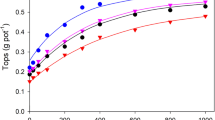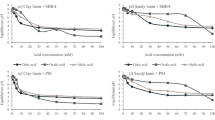Abstract
Responses of yellow serradella, slender serradella and subterranean clover to applications of superphosphate and Queensland apatite rock phosphate were compared in a field experiment in Western Australia. The rock phosphate was applied as a fine powder to a very sandy soil with a low buffering capacity for phosphate and for pH. At low levels of application, rock phosphate was about a tenth as effective as superphosphate — that is, ten times as much was required to give the same yield. With increasing levels of application, the relative effectiveness of rock phosphate declined to well below one per cent and hence more than 100 times as much was required to give the same yield. The decreasing relative effectiveness was incorporated into response equations. These were used to demonstrate that the decreasing relative effectiveness can be statistically tested and shown to be highly significant.
A simulation study using the model of Kirk and Nye showed that a decrease in relative effectiveness with increasing level of application is especially likely when the particles of rock phosphate are very small, when the levels of application are high, and when the soil's buffering capacity for phosphate and for pH is low.
Similar content being viewed by others
References
AOAC (1975) ‘Official Methods of Analysis’. 12 edn. Assoc Off Agric Chem, Washington DC
Barrow NJ (1985) Comparing the effectiveness of fertilizers. Fert Res 8: 85–90
Barrow NJ and Campbell NA (1972) Methods of measuring residual value of fertilizers. Aust J Exp Agric Anim Husb 12: 502–510
Bolland MDA (1985) responses of serradella and subterranean clover to phosphorus from superphosphate and Duchess rock phosphate. Aust J Exp Agric 25: 902–912
Campbell NA and Keay J (1970) Flexible techniques in describing mathematically a range of response curves of pasture species. Proc XI Int Grassl Cong, 332–334
Crowther EM (1947) ‘Memoranda on Colonial Fertilizer Experiments’. (HMSO: London)
Kirk GJD and Nye PH (1986) A simple model for predicting the rates of dissolution of sparingly soluble calcium phosphates in soil. I. The basic model. J Soil Sci 37: 529–540
Palmer B, Bolland MDA and Gilkes RJ (1979) A re-evaluation of the effectiveness of calcined Christmas Island C-grade rock phosphate. Aust J Exp Agric Anim Husb 19: 605–610
Author information
Authors and Affiliations
Rights and permissions
About this article
Cite this article
Bolland, M., Barrow, N. Effect of level of application on the relative effectiveness of rock phosphate. Fertilizer Research 15, 181–192 (1988). https://doi.org/10.1007/BF01050680
Accepted:
Issue Date:
DOI: https://doi.org/10.1007/BF01050680




